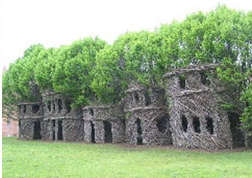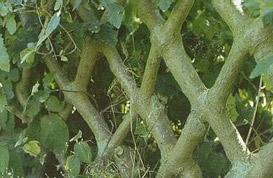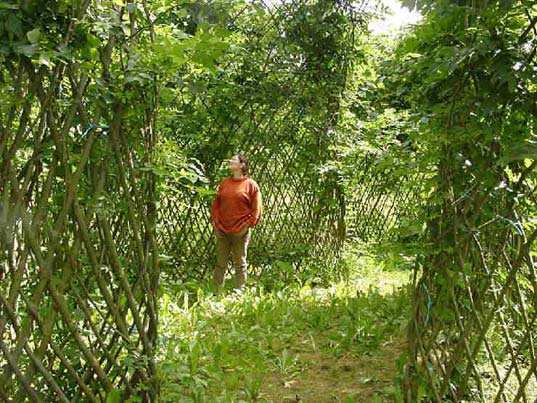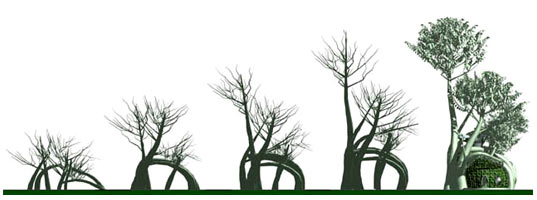Grow Your Own Treehouse
 (Inhabitat) There are houses built in trees and then there are treehouses. Last year, we had one of our first encounters with a home literally made from trees, using an ancient technique called pleaching – the art of weaving (and sometimes grafting) trees together to form structures. The Fab Tree Hab was one of the design entries for the Index: awards, emerging from the genius of a crew including MIT architect Mitchell Joachim and our friend, Javier Arbona of Archinect. The project description emphasized consideration of whole systems (and ecosystems) in creating a truly sustainable built environment, rather than a piecemeal approach that could yield uncertain longterm outcomes.
(Inhabitat) There are houses built in trees and then there are treehouses. Last year, we had one of our first encounters with a home literally made from trees, using an ancient technique called pleaching – the art of weaving (and sometimes grafting) trees together to form structures. The Fab Tree Hab was one of the design entries for the Index: awards, emerging from the genius of a crew including MIT architect Mitchell Joachim and our friend, Javier Arbona of Archinect. The project description emphasized consideration of whole systems (and ecosystems) in creating a truly sustainable built environment, rather than a piecemeal approach that could yield uncertain longterm outcomes.
Mystech: While I doubt their practicality, they are certainly beautiful and pleasing structures.
Pleaching is not exactly garden variety as building strategies go, but it’s certainly among the most ornate, natural, and “green.” German landscape architect, Rudolf Doernach, used pleaching and other techniques in what he broadly called “biotecture” or “agritecture.” Like permaculture, these methods are set up to be largely self-sustaining, meaning that once the initial planting and early training of the branches is complete, the structures continue to grow on their own, requiring minimal external energy while providing maximum agricultural yield (as in the Fab Tree Hab, which is meant to provide food for the inhabitants). Permaculture is also about inclusion, accessibility, and mutual service between humans and the natural world. With proper knowledge, you should be able to grow your own house!

As the Australian Rainforest Information Centre points out, these are the ultimate in low-cost, low-maintenance, zero-energy homes:
Doernach’s creations produce incredible savings compared to inert construction/insulation materials and have great potential for employment, given that say, 10 million homes have 100,000 hectares of plantable surface suitable for food cultivation. Insulation, energy-savings, noise-reduction, dust suppression, carbon dioxide conversion, oxygen production and psychological benefits are all positive by-products of planted walls.
Other ecological designers exploring the self-growing treehouse include Richard Reames and Konstantin Kirsch of the Treedome project, who’ve designed latticeworks of tree branches and grown them into cylindrical, multi-room dwellings which become fully-enclosed botanical domes. Fruit and other foods grow on the roof and walls, and the waste generated by the inhabitants becomes nourishment for the structure (a closed-loop system in which, as Bill McDonough says, waste=food).

Irish Architect, Urban Planner, Permaculture Designer and Ecologist, Declan Kennedy, presented a paper and lecture for the 1996 International Permaculture Conference in Australia on “designing for a sustainable future,” which includes excellent history and analysis about the evolution of ecological architecture.
If, until the mid-90s, planners were satisfied with achieving an optimal combination of outside and self-generated supply and disposal with water, energy and the necessary materials, current innovation aims higher still: zero-energy buildings are well on the way to becoming “mega-out.” What we are aiming at now are buildings that produce more energy than they consume – that is really designing for sustainability. Water-saving technologies should make way for self-contained water cycles, or failing that, wastewater-free buildings which produce compost and “industrial water,” and green spaces that produce fresh food without requiring much input – thus becoming edible parks. The emphasis is not so much on self-sufficiency as on sustainable husbandry, orienting one’s production and consumption on the carrying capacity of the land.

[…]
If energy, water, wastewater and refuse disposal rates continue to climb as they have over the past few years, every project which manages to lower running costs will become increasingly economically attractive in the future. “Non-ecological living” will become more expensive, be it food, cars or buildings. The motto is “using together instead of consuming individually.” A real opportunity for the way ahead lies in the plummeting costs of information technology and in direct links between groups with similar goals through global communication networks. These options will allow us not only to exchange information more cheaply and quickly, but also help us locate the right car, bicycle or building at the right time, in the right place and at the right price.
And this is the crux of modern ecological architecture. Rather than referencing a time before computer-generated building plans, industrial mass production, and smart home technology, ecological architecture can now embrace these advancements while staying true to a whole-systems approach to design.
By placing as much value on the services nature offers as those bestowed upon us by high-tech software and gadgetry, we optimize our design palette and gain utmost variation, flexibility, and sustainability for the future of the built environment. Product service systems and digitally networked communities thus become a part of the picture of a whole-systems lifestyle.
Most of us don’t live in houses built from trees; they generally reside in our ideas of elven fairy tales or back-to-nature die-hards. But one look at the Fab Tree Hab model makes it clear that there is an ecological architecture for the 21st century and beyond – one that draws on the intelligence of ancient practices, uses the tools of today, and looks forward toward the challenges and possibilities that lie ahead.






1 Response
[…] Mystech: Because you’ll need furniture in your newly woven/grown treehouse. […]